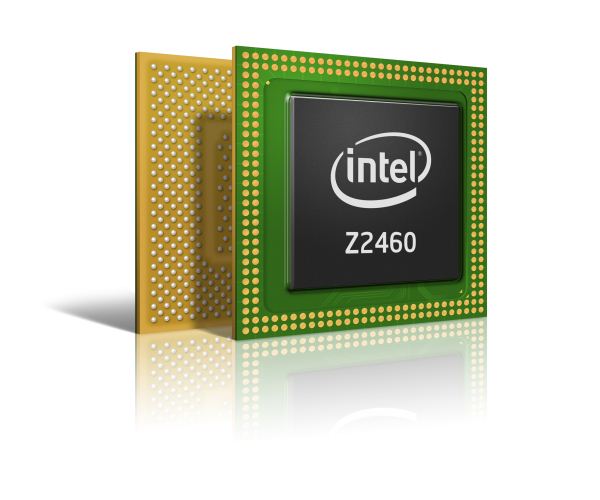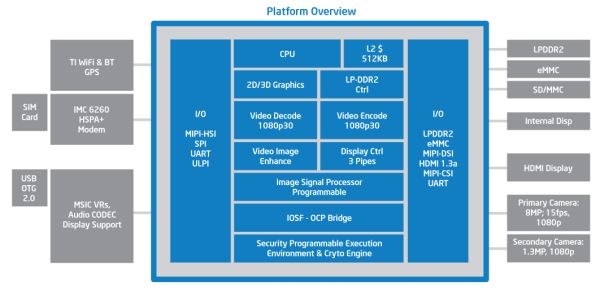Intel Goes Higher & Lower End With Atom SoCs: Z2580 & Z2000 Announced at MWC
by Anand Lal Shimpi on February 27, 2012 12:15 PM EST- Posted in
- Smartphones
- Intel
- Atom
- Mobile
- Medfield
- Tablets
- Trade Shows
- SoCs
Intel had a few updates about its Android SoC strategy for us at MWC this week. The first is a spec revision. The Atom Z2460 we talked about in great detail at CES was originally specced to run at a max of 1.3GHz but it could burst up to 1.6GHz if the thermal conditions allowed it (ala turbo boost). Z2460 yields on Intel's 32nm LP process are apparently better than expected so the Atom core will be able to turbo up to 2.0GHz instead of 1.6GHz. The default max frequency remains unchanged at 1.3GHz.
Next, Intel announced two new Atom SoCs for the smartphone market: the Z2580 and the Z2000.
The Z2580 is a higher end part, back from the fab now but shipping in devices in the first half of next year. It features the same architecture as the Atom Z2460 but instead of a single Saltwell core it has two, with Hyper Threading enabled (2 cores, 4 threads). The CPU cores can burst at up to 1.8GHz, while the default max CPU frequency remains at 1.3GHz.
The CPU isn't the only part of the SoC to get an upgrade: Intel equipped the Z2580 with a PowerVR SGX 544MP2 GPU running at 533MHz. The SGX 544 is similar to the 543 used in Apple's A5, however it adds support for Direct3D 9_3. At 533MHz you can expect roughly twice the shader/compute performance of the 543MP2 that's in the A5. Granted by early next year we'll likely see competitive, if not faster GPUs implemented in SoCs (quite possibly long before then).
The Z2580 will be paired with Intel's XMM 7160 LTE baseband. The 7160 is an upgraded version of the XMM 7060 that adds support for 3GPP Release 9. The full specs of the solution are below:
| Intel XMM7160 LTE | ||||||
| 3GPP Rel.9, FDD-LTE Cat 3 (100Mbps DL/50Mbps UL); CSFB, capable for VoLTE, SRVCC, E911 over LTE. TDD-LTE/TD-SCDMA | ||||||
| 3GPP Rel.9, DC-HSPA+ Cat 20&24/Cat7 (42Mbps DL/11.5Mbps UL) | ||||||
| 2G Quad-Band 850/900/1800/1900 MHz | ||||||
| HSPA+/UMTS Penta-Band 850/900/1900/2100/AWS MHz | ||||||
| LTE Hepta-Band 850/1800/1900/2100/AWS/2600/700 or 800 MHz | ||||||
| Android telephony framework and UI extensions | ||||||
The Z2580 also received upgrades on the modem interface side to cope with the increased bandwidth from the LTE baseband. Remember the Z2460 launched with a HSPA+ baseband pair (XMM6260).
Just like with the Z2460, Intel has produced a FFRD (Form Factor Reference Design) based around the Z2580/XMM7160. I don't have photos (nor have I seen) the new high-end FFRD, but I'm told it's a better looking design than the current Medfield design. The only detail I have about the new reference design is it comes with a larger battery: 6.771Whr.
The Z2580/XMM7160 FFRD will begin sampling in the second half of this year, with customer units shipping in the first half of next year.
| Intel Android Atom SoC Comparison | ||||||
| Low End | Mid Range | High End | ||||
| Name | Intel Atom Z2000 | Intel Atom Z2460 | Intel Atom Z2580 | |||
| CPU Clock (base/turbo) | 1.0GHz | 1.3GHz/2.0GHz | 1.3GHz/1.8GHz | |||
| GPU | PowerVR SGX 540 | PowerVR SGX 540 | PowerVR SGX 544MP2 | |||
| GPU Clock | 320MHz | 400MHz | 533MHz | |||
| Process Technology | Intel 32nm LP | Intel 32nm LP | Intel 32nm LP | |||
| Availability | 1H 2013 | 1H 2012 | 1H 2013 | |||
The Z2000 is Intel's new low-end Atom SoC SKU. While the Z2580 has two Atom cores, the Z2000 only has one. Max clock speed is limited to 1GHz and there is no support for Hyper Threading. Intel is planning on putting this core up against the ARM11 based SoCs that still sell into the low end of the smartphone space.
The GPU remains unchanged from the Z2460 (PowerVR SGX 540) however the max clock speed is limited to 320MHz (down from 400MHz). 1080p video decode is supported but video encode is limited to 720p.
The Z2000 will be paired with Intel's XMM6265 HSPA+ baseband:
| Intel XMM6265 | ||||||
| HSPA+ Rel.7, Cat 14/Cat6 (21Mbps DL/5.8Mbps UL) | ||||||
| 2G Quad-Band 850/900/1800/1900 MHz; GPRS EDGE Class 10 | ||||||
| HSPA+/UMTS Tri-Band 900/1900/2100 MHz (I/II/VIII) | ||||||
The Z2000 has its own form factor reference design, which is different from both the Z2460 and Z2580. Once again I only have a single piece of information Reference designs are especially important at the low end as they can save customers quite a bit of money. With narrow margins there's not a whole lot of room to spend on industrial design or hardware customizations. A turnkey solution that's well built and reliable will be very useful for this market.
| Intel FFRD Comparison | ||||||
| Low End | Mid Range | High End | ||||
| SoC | Intel Atom Z2000 | Intel Atom Z2460 | Intel Atom Z2580 | |||
| Modem Pairing | Intel XMM6265 | Intel XMM6260 | Intel XMM7160 | |||
| Length | 110.5mm | 123.0mm | ? | |||
| Width | 61.0mm | 63.0mm | ? | |||
| Height | 12.5mm | 9.99mm | ? | |||












25 Comments
View All Comments
zeo - Monday, February 27, 2012 - link
Intel doesn't give too much information out until the chip is actually out in the market but the first single core version of the Medfield platform reportedly has a 2.6W TDP at idle and a maximum power consumption of 3.6W when playing 720P Flash video. While more details of the dual core version is still pending.The SGX544 is limited to DX9 but the PowerVR series has versions that supports DX10.1 and the newest Power VR Series 6 supports DX 11.1 and OpenGL 4.2...
IntelUser2000 - Monday, February 27, 2012 - link
That's not CPU power, but overall platform power usage when idle and in load scenarios. So everything like memory, storage, screen, auxiliary devices use power.Lucian Armasu - Tuesday, February 28, 2012 - link
Regardless, Krait and other ARM chips use a lot less, even under maximum load, let alone for the idle mode.iwod - Monday, February 27, 2012 - link
Are those numbers right? It seems quite high to me compare to what Anand present to us earlier on.I am getting slightly worried, because Intel has the resources and power as well as known how to literally everything in the semiconductor industry. And how they manage to catch up in such a short space of time.
22nm will bring them on par with power usage.
Then there is price which will sort itself out once Intel manage to overlap its SoC competitor by one nodes.
I am worried.....
Lucian Armasu - Tuesday, February 28, 2012 - link
It looks like they won't have a 22nm until 2014. They might be able to catch-up in energy efficiency by then, but they can't do that by keeping pace with the performance increases that ARM chips also get.And their catching up is by no means fast. They've been trying to launch an Atom based phone since 3-4 years ago, and it still seems they have more catching up to do in the power consumption department.
Also, ff a single core has a ~3W TDP, then their 2 cores chip will probably have an even higher TDP. They couldn't have cut the power consumption in half, while also doubling the performance in just one year. That's basically a 4x difference. Intel chips usually have only 30-40% difference in either power consumption or performance every year. They can't advance faster than that.
Hector2 - Tuesday, February 28, 2012 - link
"It looks like they won't have a 22nm until 2014" That's just wishful thinking.Intel's x86 PC chips could never match ARM at 45nm. They knew they'd need at least 32nm & they just used 45nm to get everything ready.
The delay until June for 22nm volume production will have no effect on the 22nm entry into smartphones. It seems that lower volume 22nm production server chips will start shipping in April and a delay in volume fab starts won't hold up converting the 32nm Medfield design to 22nm and getting it ready for prime time. We'll see 22nm Medfields shipping in 2013. We'll probably see first 14nm samples in 2014.
At what point do the chips get so small and power efficient that they pass ARM in performance, power & cost ? Probably 22nm.
iwod - Tuesday, February 28, 2012 - link
3W? Anand article stated otherwise.And as Hector has pointed out TriGate 22nm LP will bring power / performance on par with ARM.
It is only a matter of cost.
mosu - Monday, February 27, 2012 - link
thank you, zeo.can you provide a link?scores87 - Monday, February 27, 2012 - link
can someone at anand can post a benchmark between intel and krait?Lucian Armasu - Tuesday, February 28, 2012 - link
I'm sure they will do once it hits the market. I hope they compare it with whatever is the most powerful then, and they also do a comprehensive test, including a video of how both react in the same time.A single Sunspider test will not be nearly enough, and even that should be done with the same browser, so the browsers' own JS engines don't skew the results too much.